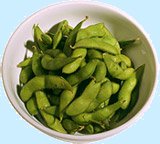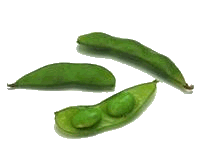Instead of Fritos, Doritos, Cheetos, or Tostitos ... Consider Edamame
by www.SixWise.com
Edamame, the Japanese word for grean soybeans, is an integral
part of Asian cuisine -- one that is becoming increasingly
popular with health-conscious Americans. That's because one
of the most common ways to enjoy this vegetable is by boiling
and salting the pods, then squeezing the beans out for a quick,
tasty snack.
|

Edamame can be purchased in the pod or already shucked.
|
While you still won't find edamame on the shelves of gas
stations like bagged chips, many grocery stores now sell the
beans flash-frozen and already salted, so all you need to
do is boil them. Or you can grab them completely prepared
from a Japanese restaurant if there is one in your area. Point
is, when you crave a salty snack, they're only slightly less
convenient than grabbing a bag of chips ... but they don't
come with the health risks of frying, the negligible nutritional
value, or the unsavory additives and preservatives.
Why Edamame?
Edamame, which literally means "beans on branches,"
is quite nutritious. Aside from being high in protein and
low in fat, studies have found that isoflavones in soybeans
may help:
- Reduce the risk of breast cancer in premenopausal women
- Decrease the risk of osteoporosis
- Promote prostate health
- Protect cells with their antioxidant properties
Edamame also qualifies for the FDA-approved health claim
for labels of soy foods, "Diets low in saturated fat
and cholesterol that include 25 grams of soy protein a day
may reduce the risk of heart disease."
|

Edamame Nutrition Facts
| Nutrition |
Value |
% DV |
| Serving Size |
1/2 cup
(75g) |
|
Amount per Serving:
Calories |
100 |
|
Amount per Serving:
Calories from Fat |
25 |
|
| Total Fat |
2.5g |
4% |
| Saturated Fat |
0g |
0% |
| Cholesterol |
0mg |
0% |
| Sodium |
70mg |
3% |
| Total Carbohydrates |
9g |
3% |
| Fiber |
1g |
4% |
| Sugars |
2g |
|
| Protein |
10g |
|
| Vitamin A |
|
10% |
| Vitamin C |
|
0% |
| Calcium |
|
8% |
| Iron |
|
8% |
|
The History of Edamame
Edamame may be new in America, but it has been around in
China (where it's called mao dou) as far back as 200 B.C..
This is where edamame originated, and it was used as a medicinal
food. The first recorded use of edamame in Japan wasn't until
927 A.D., when it was described in the Engishiki, a guide
to agricultural trade. The pods were then used as an offering
at Buddhist temples.
Does Soy Present Health Risks?
Some believe that soy may not be the health "wonder"
food it's claimed to be. A major aspect of the concern is
that soy isoflavones are phytoestrogens, a weak form of estrogen
that could have a drug-like effect in the body. It is a controversial
issue, and some studies suggest that high isoflavone levels
might actually increase the risk of cancer, particularly breast
cancer.
Daniel Sheehan, Ph.D., director of the Estrogen Knowledge
Base Program at the FDA's National Center for Toxicological
Research, says isoflavones should be consumed "cautiously."
He says, "While isoflavones may have beneficial effects
at some ages or circumstances, this cannot be assumed to be
true at all ages. Isoflavones are like other estrogens in
that they are two-edged swords, conferring both benefits and
risks."
It seems the key to avoiding such health
risks when it comes to soy is to stick with only unprocessed
varieties, such as edamame, and consume them along
with a healthy, varied diet.
In fact, a study in the June 2004 issue of Carcinogenesis
found that processed soy products and supplements have a significantly
lower ability to prevent cancer, and may actually stimulate
the growth of pre-existing estrogen-dependent breast tumors,
compared with whole soy foods.
"These partially purified isoflavone-containing products
may not have the same health benefits as whole soy foods,"
said William G. Helferich, professor of food science and human
nutrition at the University of Illinois at Urbana-Champaign
and one of the study's lead authors.
The researchers suggested that it may be wise to avoid processed
soy products and supplements that contain isoflavones in more
purified forms, which is how many Americans consume soy.
Instead, they said to choose minimally processed whole soy
foods including edamame, whole soy flour, tofu or tempeh.
Tasty Edamame Recipes
Edamame can, of course, be eaten plain as a delicious snack,
but the beans are so versatile that they can be added to everything
from salads to soups and casseroles. Depending on your nutritional
needs, you may want to look for organic or salt-free varieties,
all of which can be found in health food stores, Asian markets
and some regular grocery stores.
The University of Kentucky College of Agriculture has put
together a free edamame cookbook, which has over a dozen unique
ways to add edamame to your meals at home.
Get
Your Edamame Recipe's Now!
Recommended Reading
The
Power of the Pomegranate: The 9 Health Benefits of this Wonder
Fruit, and How to Eat Them
The Healthiest
Grasses You Could Possibly Eat (Hint: Not Your Lawn)
Sources
FDA:
Health Claims for Soy Protein
Kentucky
Edamame
Edamame:
The Vegetable Soybean
The
World's Healthiest Foods
To get more information about this and other highly important topics, sign up for your free subscription to our weekly SixWise.com "Be Safe, Live Long & Prosper" e-newsletter.
With every issue of the free SixWise.com newsletter, you’ll get access to the insights, products, services, and more that can truly improve your well-being, peace of mind, and therefore your life!
|